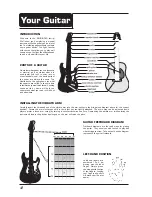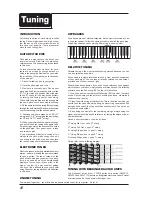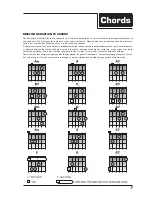
6
GUITAR PITCH PIPE
Pitch pipe is a pipe that you can buy at your
local music store. Blow into it to produce a
reference tone. The guitar string is then tuned
to this tone.
So lets start with what we know for sure:
there are six strings on your guitar and six
holes in the pitch pipe. Now how do you match
the six sounds of the pitch pipe to the sound
of the strings?
1. Sit comfortably and hold your guitar.
2. Have the pitch pipe near you.
3. Now here is the tricky part. Pick up your
pitch pipe and blow through the hole marked
E1. Try to match the sound of the pitch pipe
to the E1 string (all the way at the bottom)
by turning the tuning key for that string.
When both the pitch pipe and the string have
the same pitch, youre done with that string.
4. Do the same for the top string (E6) by blowing
through the hole marked E6 and turn the tuning
key for that string until the sounds match.
5. Continue the same steps to do B2 (2
nd
string) and A5 (5
th
string) and the same thing
for G3 and D4 (3
rd
and
4
th
string).
6. When you are finished tuning all six strings,
go back through the tuning once again to be
sure all strings match the sounds of the notes
on the pitch pipe. Your guitar is now in tune
and ready to play.
If you experience difficulty in tuning all six
strings to the pitch pipes tones, tune only
one string to the pitch pipe and then tune
the rest by using the relative tuning method.
KEYBOARDS
If you have a piano or electric keyboard, heres a quick overview of how
to tune your guitar. Follow the same procedure as with the pitch pipe.
Which key corresponds to which guitar string is shown below.
RELATIVE TUNING
Relative tuning is the most versatile tuning method because you can
use it anywhere and anytime.
All you need is a single reference tone (e.g. from another instrument
or your pitch pipe). You can tune all strings relative to one another,
provided one of them is tuned right.
What makes it even better: if you dont have a reference tone against
which to check your pitch, simply choose a reference tone. The following
example uses the 6th string (E6) as the reference tone.
1. Tune the open (no chord played) 6th string (E6) to a clear, low-pitch
sound. Get the string to the point of not being too loose, otherwise it
will buzz when you play.
2. Press the sixth string at the fifth fret. This is the pitch to which you
should tune the open fifth string. Keep on strumming the pressed 6th
string and the open 5th string until their sounds match. They are now
in tune with one another.
3. Keep doing the same for the remaining strings, always using the
higher-numbered string as the reference for tuning the adjacent lower-
numbered string.
Heres a short overview of how its all done:
6
th
string 5th fret = open 5
th
string
5
th
string 5th fret = open 4
th
string
4
th
string 5th position = open 3
rd
string
3
rd
string 4th position = open 2
nd
string
2
nd
string 5th position = open 1
st
string
Simply refer to the following diagram:
INTRODUCTION
Correcting the
pitch
of each string is called
tuning. Pitch simply means how high or how
low the sound of a musical instrument (in
this case, your guitar) is. There are several
ways to tune your guitar:
ELECTRONIC TUNER
Electronic tuners are widely available at music
stores, and are probably the easiest method
to tune a guitar. The tuner listens to the
pitch of each string as you strum it, one at a
time, and uses an easily understandable
display to let you know if your pitch is too
high or too low. You may consider getting
one if you find it difficult to tune your guitar
using the other tuning methods we describe
in this book.
ONLINE TUNING
At www.behringer.com, you will find an awesome online tuner for your guitar. Go for it!
TUNING WITH BEHRINGER GUITAR AMPS
The 2-channel amps of our V-TONE guitar amp series (GMX212,
GMX210 and GMX110) feature an integrated electronic tuner! Further
information can be found at www.behringer com.
Содержание STRAT
Страница 1: ......



























